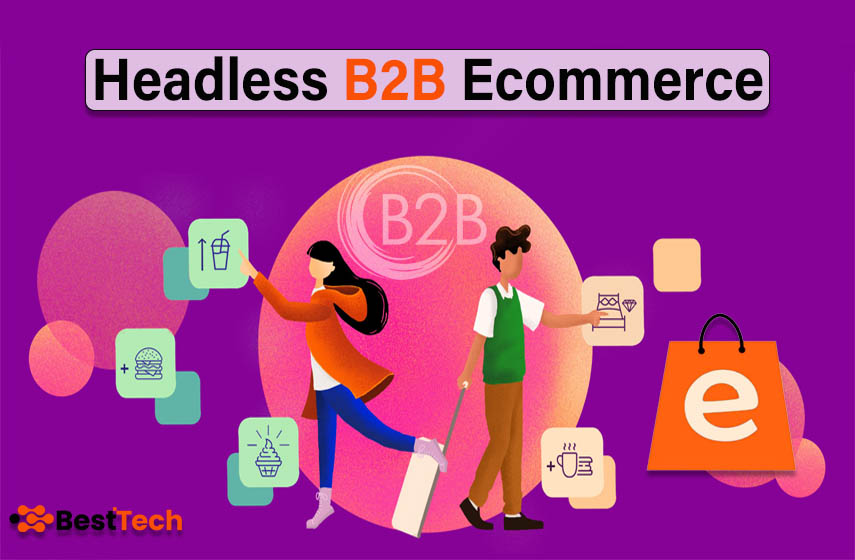The world of e-commerce is constantly changing, and one of the latest trends attracting attention is headless B2B e-commerce. This innovative approach to online business is changing the way companies sell to other businesses. Headless B2B e-commerce is a modern approach to online selling where the “front-end “and the “back-end” are decoupled or separated. In traditional e-commerce, these two parts are tightly connected. It allows companies to launch and manage online storefronts without the need for a bulky, all-encompassing legacy system. In this blog post, we have explained the complete knowledge about Headless B2B Ecommerce.
How Does Headless B2B Ecommerce Work?
In the under section, we have explained the headless B2B Ecommerce work:
Front-End & Back-End
The customer viewpoint and attracting them through your website is referred to be the front-end or presentation layer in a headless system. It’s in charge of handling the shopping cart, presenting products, and creating a user-friendly interface. The logic layer, sometimes referred to as the back-end, manages all the important operations in the background. This involves handling client data, processing orders, keeping track of records, and managing product information.
APIs and CMS
APIs act as bridges between the front-end and back-end. They allow these two layers to communicate and exchange information flawlessly. Think of APIs as messengers that transmit data back and forth. In a headless e-commerce setup, the CMS is decoupled from the front-end. It means that you can choose the CMS that best suits your content needs without affecting the way your website looks and functions.
Pros of Headless B2B Ecommerce
Pros or benefits of Headless B2B Ecommerce are listed below:
Unparallel Flexibility & Scalability
Headless e-commerce provides unmatched flexibility. You can customize the front-end and back-end independently, allowing for unique user experiences and efficient back-end operations. Headless systems are highly scalable. As your business grows, you can easily add new features, integrations, and functionalities without disrupting the entire platform.
Speed and Performance
You can modify each for performance and speed as the front-end and back-end work separately. As a result, we improve user experience and reduce page loading times. Through the use of APIs, headless e-commerce enables you to sell your goods on a variety of platforms, including websites, mobile apps, marketplaces, and even IoT devices.
Personalization & Quickness
You can implement advanced personalization techniques with comfort in a headless setup. Modify content and product recommendations to individual customers, enhancing their shopping experience. Separating the front-end and back-end makes it simpler to respond to shifting market demands and technological advances. You can readily integrate new tools and technologies without completely revamping the system.
Cons of Headless B2B Ecommerce
The cons or disadvantages of Headless B2B Ecommerce are listed below:
Needs a Larger Development Team
Developers may have difficulties with headless systems, necessitating the use of a larger team with specialized knowledge. Expanding the developer team needs more demands and costs, yet doing so is frequently a vital investment for managing and maintaining a headless commerce solution. Customization and better client experiences may exceed the expenditures in a positive way.
Higher Development Costs
A headless system can cost more to build and operate than a conventional e-commerce platform. The upfront development expenses, which include building the front-end interface and APIs, might be high. Upkeep and updates that are ongoing could result in additional costs.
Dependency on Developers
Maintaining and updating a headless e-commerce platform typically requires ongoing developer involvement. You may need to rely on developers for routine tasks, which can be a constraint for smaller businesses or those with limited access to development resources.
Learning Curve
Transitioning to a headless e-commerce model may require your team to learn new technologies and workflows. This learning curve can affect productivity and efficiency during the initial stages of implementation.
Content Management Challenges
While headless CMSs offer flexibility, managing content in a decoupled system can be more complex than using an integrated CMS. Content updates may require additional steps, and ensuring content consistency across various channels can be challenging.
Retailer Selection
Choosing the precise retailers for your headless e-commerce stack can be critical to success. Evaluating and selecting compatible vendors for front-end development, back-end systems, and third-party integrations can be time-consuming and may require extensive research.
Security Concerns
Managing security in a headless e-commerce system requires careful attention. Inadequate protection may result in increased vulnerability to security breaches when multiple points of integration and communication are present.
Scalability Management
While headless systems offer scalability, managing this scalability effectively can be a challenge. As your business grows and evolves, ensuring that your headless architecture can accommodate increased traffic, data, and complexity becomes high.
The Bottom Line
Headless B2B e-commerce represents a best approach to online selling, offering flexibility, scalability, and enhanced customization. While it may not be suitable for every business, those with complex needs and a desire for innovation can benefit greatly from adopting this model. Ultimately, the decision to go headless should align with your business goals, resources, and commitment to delivering exceptional online experiences to your customers. So, be active and go through every point before choosing Headless B2B Ecommerce for your business.

